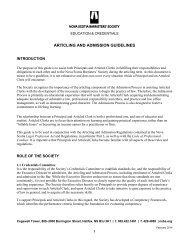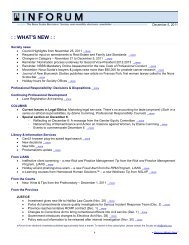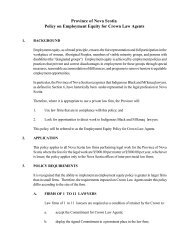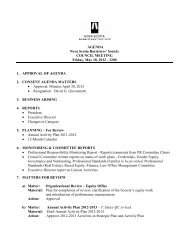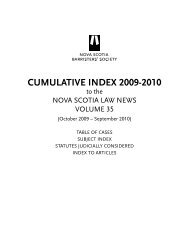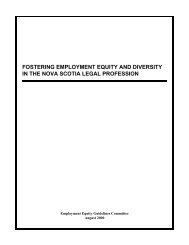SR Vol 25 No 1, January 2007 - Nova Scotia Barristers' Society
SR Vol 25 No 1, January 2007 - Nova Scotia Barristers' Society
SR Vol 25 No 1, January 2007 - Nova Scotia Barristers' Society
Create successful ePaper yourself
Turn your PDF publications into a flip-book with our unique Google optimized e-Paper software.
Has SCC, with the new ceilingof $<strong>25</strong>,000, gotten tooPaul DrysdaleCreighton, Shatford & Drysdalefar away from its original intention?Has this become anaccess to justice issue, since it’s the only forum for lay litigants?When Small Claims Court limits were raised to $<strong>25</strong>,000 in 2005, Iwas surprised to learn that there had been no representations of anykind made on the subject to government by the profession. AlthoughI am not one to encourage the Barristers’ <strong>Society</strong> to involve itself inissues where the protection of the public is not directly involved, itcaused me some concern to learn that this legislation was passedwithout comment from those practising within the system. In myview, the Small Claims Court has been moved dangerously awayfrom its original purpose, which was to provide quick, informal andfair decisions on simple issues between individuals, toward a situationwhere unsophisticated individuals, facing substantial claimsfrom bill collectors and other experienced corporate representatives,or from represented opponents, may find themselves at a significantdisadvantage.There is need for reformin order to reduce thecosts and delays involvedin litigation. Chief JusticeMcLachlin recentlywas quoted by the CanadianPress as saying that,“Legal fees are so highthat up to 40 per cent oflitigants are now representingthemselves at trial,armed with a weak ornon-existent grasp of thelaw.” This, in itself, can cause great strain on the court system.It is obvious that costs of litigation are no doubt a threat to the averageperson’s access to the courts. Over-broad discovery and increasingnumbers of pre-trial procedures are increasing costs to a point whereprosecuting just claims is simply not cost effective. Ordinary peopleare unable to afford the costs of bringing these claims before thecourts. In raising the Small Claims jurisdiction to $<strong>25</strong>,000, however,it is submitted that the access to simple, inexpensive justice – that theSmall Claims Court is intended to provide – is put at risk.Should general damages be increased from their current $100?If not, why?<strong>No</strong>.Do you feel, since the stakes are now much higher ($<strong>25</strong>,000, asJustice Warner recently stated, is more than the average <strong>No</strong>va<strong>Scotia</strong>n makes in a year), that there should be greater proceduralrules, including pre-hearing disclosure of documents and recordingof hearing?I cannot imagine that a $<strong>25</strong>,000 claim could be considered “small”by many individuals in <strong>No</strong>va <strong>Scotia</strong>. Any of us who appear in SmallClaims Court regularly are aware that more lawyers are appearing onbehalf of litigants as amounts involved become more significant. Wetherefore retain many of the problems of legal costs without the proceduralprotections provided by the Civil Procedure Rules. There are norules for pretrial disclosure of witnesses, documents or other evidence.There is no method of encouraging pre-trial negotiation, since partiesmay not know the other side is represented until they show up atcourt for their hearing. How often have you appeared at Small ClaimsCourt with a client, having prepared for trial and subpoenaed witnesses,only to have the unrepresented party on the other side, whetheran individual or a corporation, ask for an adjournment of the hearingin order to get counsel to “level the playing field”?There is often a relaxation of the strict rules of evidence, resultingfrom the “informal’ nature of the Court. There is no record of theevidence taken – other than the adjudicator’s notes, and no appeal,other than by way of stated case. There are no significant cost consequencesto unsuccessful litigants, even where the successful partymay have gone to the expense of having legal counsel. More importantly,I submit, given that I always understood the purpose of pretrialdisclosure to be the encouragement of settlements, the absenceof any kind of process forthis has the potential tocreate more litigationrather than less.“Any of us who appear in SmallClaims Court regularly are awarethat more lawyers are appearingon behalf of litigants as amountsinvolved become more significant.”I am in complete agreementwith those who saythat the costs of and thedelay inherent in pretrialprocedures is often whatlimits the average person’sability to seek the protectionof the Courts for justice.I do question, however,the solution of raisingthe Small Claims limits, without adding some procedural protections.An alternative solution was proposed by the Canadian Bar Associationin the 1990s and an example can be found in New Brunswick, whereRule 79 of the Rules of Court has recently been added to provide fora simplified procedure in claims under $50,000, without affecting theSmall Claims limits of $6,000. I encourage you to access Justice DavidH. Russell’s overview of the new rule, which can be found on the Webat www.cba.org/NB/pdf/Rule%2079.pdf . The procedure provides forearly and mandatory disclosure of documents and witness statements,no expensive discovery proceedings, expedited hearings and time limits,and serious cost consequences for failure to comply with the rules.This type of rule has successfully been in effect in Ontario, Manitobaand Saskatchewan for some time.<strong>January</strong> <strong>2007</strong> 19



